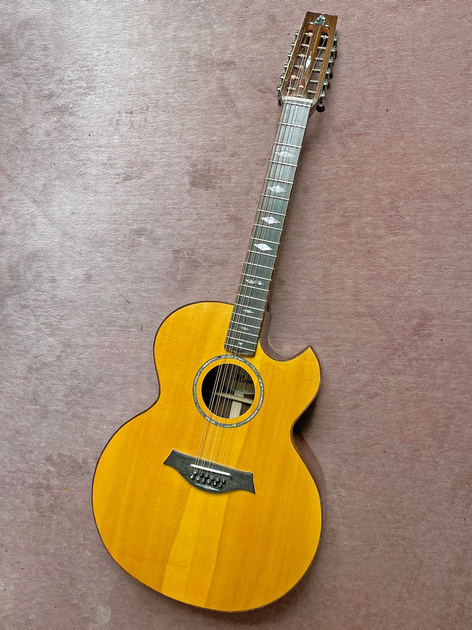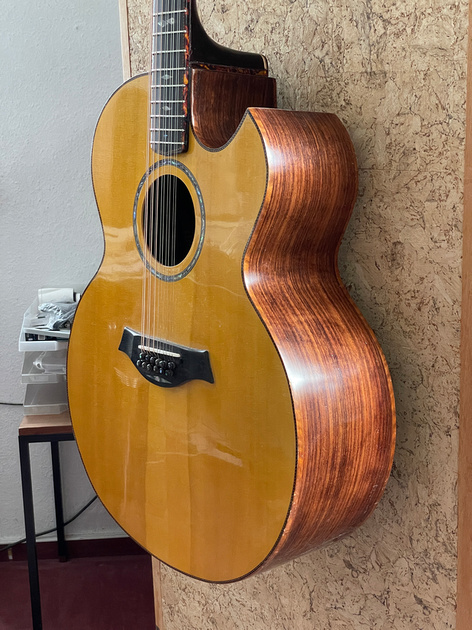
 |
|
#1
|
|||
|
|||
|
My 12-string guitar should sound a little fuller.
Maybe would it help to lighten the top braces? "Scalloping"? Would sanding possibly help? Another idea? Remove the back and then work on it is too intensive labor for me!
__________________
Thanks!  Martin D28 (1973) 12-string cutaway ...finished ;-) Hoyer 12-string (1965) Yamaha FG-340 (1970) Yamaha FG-512 (ca. 1980) D.Maurer 8-string baritone (2013-2014) and 4 electric axes |
|
#2
|
|||
|
|||
|
There is no need to remove the back to get to the braces. What do you mean by "fuller?"
|
|
#3
|
|||
|
|||
|
More bass and a tad louder … for a jumbo.
__________________
Thanks!  Martin D28 (1973) 12-string cutaway ...finished ;-) Hoyer 12-string (1965) Yamaha FG-340 (1970) Yamaha FG-512 (ca. 1980) D.Maurer 8-string baritone (2013-2014) and 4 electric axes |
|
#4
|
|||
|
|||
|
More bass and a tad louder … for a jumbo.
I could work though the sound hole I guess.
__________________
Thanks!  Martin D28 (1973) 12-string cutaway ...finished ;-) Hoyer 12-string (1965) Yamaha FG-340 (1970) Yamaha FG-512 (ca. 1980) D.Maurer 8-string baritone (2013-2014) and 4 electric axes |
|
#5
|
||||
|
||||
|
There is tremendously more involved than this.
Thinning the braces doesn't make the top respond more because of reduced weight. Scalloping the braces changes the structural strength of the braces, allowing it to FLEX more. Also, by "sanding" the brace on the back to reduce weight will be a ridiculously difficult prospect with infinitesimal results. So the short answer: no this is a terrible idea because 1) it wont work and 2) it will likely make things much worse Your better bet is to go *UP* in string gauge so that the strings impart more energy to the top to drive the sound. Try that first - you mioght be pleasantly surprised
__________________
Fazool "The wand chooses the wizard, Mr. Potter" Taylor GC7, GA3-12, SB2-C, SB2-Cp...... Ibanez AVC-11MHx , AC-240 |
|
#6
|
|||
|
|||
|
It's not something you're going to figure out on a forum. If you don't care about the instrument or don't mind re-bracing it, you can have at it. If you care at all about the instrument, and want to learn a new skill, there's online classes that go through this. There's no simple trick to it.
|
|
#7
|
|||
|
|||
|
Are the back lower back braces tall or are they the low wide ones? You can actually bring out more bass by making the lower bout back braces more flexible with less mass and it's much safer then shaving the top.
You can do a nondestructive test that will predict the outcome of shaving the back braces by getting some poster putty and attaching it to the back right over the brace on the outside of the guitar. IT helps to have something that measures the frequencies. The App called Luthiers Lab can do that for you. If you get a noticeable drop in freq then shaving the brace will have a similar effect. That's what I would try first. You can bring out more bass if the top braces are not scalloped but you have to be very careful there because a little bit goes a very long way. |
|
#8
|
|||
|
|||
|
@fazool: I´ll have to have a look at the braces and compare them with their size in the plan I followed when building this guitar.
The idea of going up in the string gauge is a solution I have to try first. @ Bowie: I do care about this instrument because I built it. Btw, I don´t want to learn any new skill...  @redir: the back lower braces are the low wide ones. Thanks for mentioning the App called "Luthiers Lab"! I´ll give that a try. --->@ Luthiers Lab: It´s a free Android app - but I´m only working with Apple... 
__________________
Thanks!  Martin D28 (1973) 12-string cutaway ...finished ;-) Hoyer 12-string (1965) Yamaha FG-340 (1970) Yamaha FG-512 (ca. 1980) D.Maurer 8-string baritone (2013-2014) and 4 electric axes Last edited by viento; 02-12-2024 at 04:02 AM. |
|
#9
|
|||
|
|||
|
It's a complicated matter. It could be the bracing. It could be the thickness of the top. It could be an x brace. It could be a tone bar. It could be a back brace. You have less than a 50/50 chance of making it sound better. Some luthiers will "voice" a guitar by expertly sanding the bracing after the guitar was built. You'll be learning on your guitar. And, most don't become an expert with their first DIY project. Good luck!
__________________
"Lift your head and smile at trouble. You'll find happiness someday." |
|
#10
|
|||
|
|||
|
Well, sounds like the two best options are hiring someone capable or doing nothing. I can't recommend working on a guitar you care about if you don't want to learn how to do the work properly.
|
|
#11
|
|||
|
|||
|
Quote:
Example 1 Example 2 Hey, maybe I'll try it myself while I have the opportunity... 
__________________
Just reclining in a place where I am exercising the Swedish national sport of fully over estimating my superiority in the English language. Last edited by Henning; 02-10-2024 at 01:11 PM. |
|
#12
|
|||
|
|||
|
A smaller sound hole can help to emphasize bass. You could try binding your soundhole which would reduce the diameter by about 3mm. This could be tried temporarily, holding the binding on with 2 sided or masking tape.
I do know a guy with a 70's D-28 who scalloped his braces through the soundhole and it sounds great but that's not a 12 string. You built the guitar? What is the top thickness? More than 3mm? How wide and tall are the straight?braces? More than 8mm x 14mm? How big and thick the bridge plate? Thicker than 3mm? |
|
#13
|
|||
|
|||
|
The sound hole is about 9cm diameter, thus not too big I guess.
You built the guitar? ---> yes about 3 or 4 years ago What is the top thickness? More than 3mm?----> 3.1mm How wide and tall are the straight braces? More than 8mm x 14mm?---> no, the same How big and thick the bridge plate? Thicker than 3mm?---> no This is the culprit:  
__________________
Thanks!  Martin D28 (1973) 12-string cutaway ...finished ;-) Hoyer 12-string (1965) Yamaha FG-340 (1970) Yamaha FG-512 (ca. 1980) D.Maurer 8-string baritone (2013-2014) and 4 electric axes |
|
#14
|
|||
|
|||
|
Often the best way to improve the bass response is to shave back braces. If the lowest tap tone of the back is much higher in pitch than the 'main top' resonance dropping the back pitch will get it working better with the top in the low range. Structurally, reducing back braces is less risky than taking material off the top braces. Block the sound hole when you're checking the top and back pitches, to prevent the low 'main air' resonance from masking their sound.
It's also fairly easy to check the idea out without any risk. Just find the spot on the back that produces the strongest low tap tone and stick on a wad of poster adhesive. This drops the pitch of the resonance in the same way that reducing brace stiffness does, but if you don't like the outcome it's easier to remove the poster adhesive than it is to reinforce the braces. The closer the 'top' and 'back' pitchers are the greater the effect. Backs are often a musical third or more higher in pitch than the top, and sometimes as much as a fifth. On 'better' guitars they will often be more like a couple of semitones apart, and there is probably little risk to the sound if the back is just one semitone higher. I would avoid getting much closer than that, though. When the back is close in pitch to the top it acts as a sort of extension of the top area in the low range. |
|
#15
|
|||
|
|||
|
I shaved the back braces of an overbuilt guitar and it helped in the bass. I do the tap test to see how loose the back (or top) is to decide how much needs to be done. A thud without any resonance calls for some action. That is unless the plate thickness is too much.
__________________
Fred |